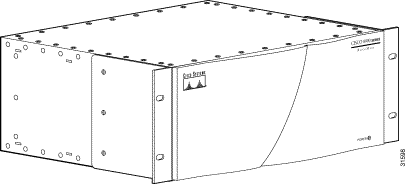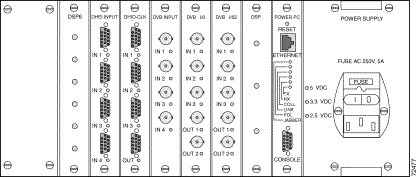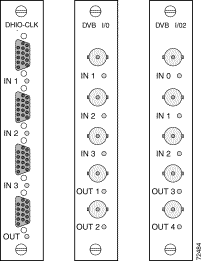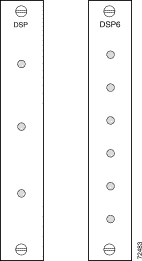|
|

This chapter provides physical and functional overviews of the Cisco 6920. It contains physical descriptions of the unit's hardware and functional descriptions of hardware and software components. The chapter contains the following sections:
The Cisco 6920 (see Figure 1-1) is a real-time bandwidth management solution for digital cable operators and digital video service providers. Available in a compact four-rack unit (4RU) rack-mounted system, the Cisco 6920 uses high-speed programmable digital signal processors (DSPs) to dynamically perform real-time rate conversion and bitstream manipulation on encoded MPEG-2 streams. This maximizes audio, video, and data signal throughput and effectively widens bandwidth capability, while ensuring quality transmission at full transponder link rates.

The Cisco 6920 accepts up to 15 MP&ML MPEG-2 input signals through DHEI or DVB-ASI compliant interfaces. (See Figure 1-2.)

The unit's programmable statistical remultiplexing engine then performs real-time variable bit rate (VBR) and constant bit rate (CBR) conversion and bitstream manipulation processing to the
input streams.
The Cisco 6920 uses a proprietary statistical model to recombine the processed streams into a highly efficient, multiplexed program transport stream, while maintaining video quality. The processing engine of the Cisco 6920, aside from performing static and dynamic grooming, also supports PID filtering and PCR jitter removal.
The Cisco 6920 can be mounted in an equipment rack. Each basic unit comes equipped with the following components:
Based on input requirements and selected features, you will also install one or more of the following components:
The PowerPC card is the CPU card that controls the operation of the Cisco 6920. (See Figure 1-3.)

An Ethernet cable connects the PowerPC card in the Cisco 6920 either to a network or directly to a computer equipped with a web browser (Netscape Communicator or Microsoft Internet Explorer). The RateMux Manager graphical user interface software (pre-installed on the PowerPC card) runs on your computer's web browser to start up and configure the Cisco 6920.
Each DVB-ASI and DHEI input/output card is equipped with three input connectors. The DVB-ASI I/O card is equipped with two output connectors with identical output streams. The DVB I/O2 card is equipped with two separate output connectors which can support two independent output streams. The DHEI I/O card is equipped with one output connector. (See Figure 1-4.)

For DVB-ASI video input—If you have only one video input stream, you can use any of the three input connectors on the DVB-ASI I/O card.
For DHEI I/O video input—Any of the input connectors can be used if the clocking is to be internally generated. If external clocking is being used to generate the muxed outputs, the top input connector (module 0) must be used for video input.
 |
Note Earlier versions of the DHEI I/O card (before Revision 3) did not provide for internal clocking and required the mandatory use of the top input connectors. |
Each DVB-ASI input card is equipped with four input connectors, and each DHEI input card has three input connectors. (See Figure 1-5).

The DSP3 and DSP6 cards are the video processors of the Cisco 6920. (See Figure 1-6.)

Each DSP3 card has three DSP processors and each DSP6 card has six processors that perform digital grooming, rate conversion, and all other video processing functions. Each Cisco 6920 supports from one through six DSP cards of either type. The number of DSP cards required depends on your application and features implemented.
The Cisco 6920 is compatible with the defined PAT and PMT tables of the ISO/IEC 13818-1 MPEG-2 standard. The Cisco 6920 reads the PAT and PMT tables of all input sources, and precisely displays these tables and generates an accurate PAT and set of PMTs for the output channels. The generated table reflects your program selections and any remapping of the PID or program values. The ECM value remains constant, equal to the value at input.
The DVB consortium has extended the basic MPEG PSI tables (in documents EN 300 468 and others) to support a services model and additional data types such as teletext, subtitles, and EPG. The ATSC has similarly expanded the MPEG PSI tables (in documents A/65, A/66, and A/67) to support legacy
VBI data, EPG, V-Chip, Conditional Access, and HDTV. The Cisco 6920 has the ability to remultiplex such data into an MPEG MPTS along with video and audio components, but does not have the ability (nor do most MPEG multiplexers) to regenerate the DVB-SI/PSIP tables to merge discrete DVB-SI/PSIP input streams. This function would typically be done in a stand-alone DVB-SI/PSIP generator device, whose output could then be forwarded to the Cisco 6920 for remultiplexing.
![]()
![]()
![]()
![]()
![]()
![]()
![]()
![]()
Posted: Fri Sep 27 00:16:57 PDT 2002
All contents are Copyright © 1992--2002 Cisco Systems, Inc. All rights reserved.
Important Notices and Privacy Statement.